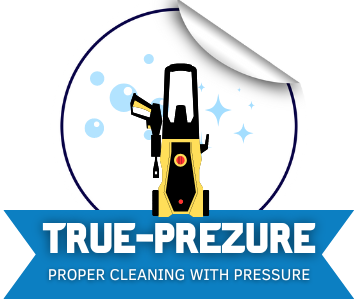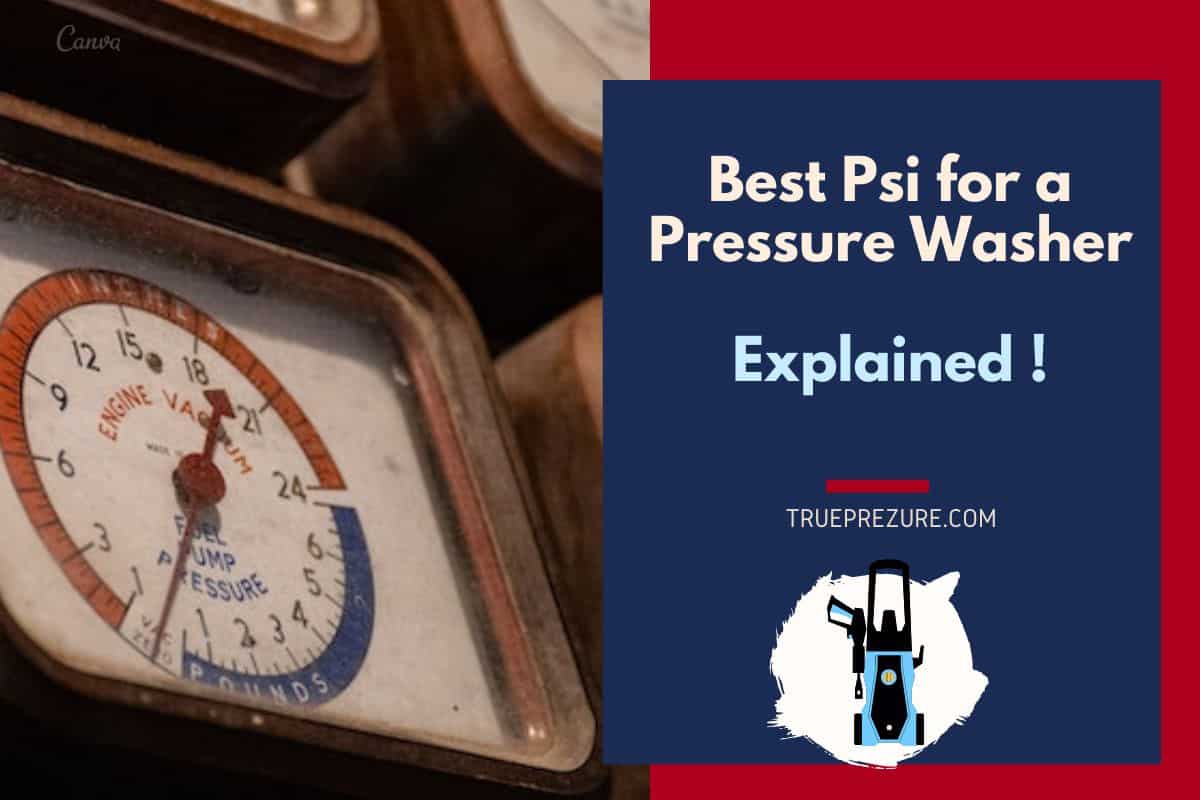Are you tired of spending hours scrubbing away dirt and grime on your outdoor surfaces or your car surfaces?
A pressure washer might just be the solution to your cleaning woes. But with so many different models and PSI options available, it can be confusing to choose the best one for your needs.
In this comprehensive guide, I will break down everything you need to know about PSI (pounds per square inch) and GPM (gallons per minute) for you, and explain what is best psi for a pressure washer, how to determine the ideal PSI range for different surfaces to clean, give tips on using a pressure washer effectively, discuss nozzle types, compare high vs low-pressure washers, and many more!
So let’s dive in!
What Is the Best Psi for a Pressure Washer?
When it comes to pressure washers, PSI is a critical factor in determining the power and effectiveness of the machine. PSI stands for pounds per square inch and refers to the amount of pressure that the water is being forced out at.
The higher the PSI, the more powerful your pressure washer will be.
https://hotsyequipmentcompany.com/
in my point of view, it’s important to note that there isn’t a one-size-fits-all answer when it comes to what PSI is best for a pressure washer. Different surfaces require different levels of pressure.
For example, you wouldn’t want to use high-PSI settings on delicate surfaces like wood or siding as this could cause damage.
As a general rule of thumb, 1, Lower PSI ranges (around 1300-2000) are suitable for lighter tasks such as washing cars or outdoor furniture. 2,Medium-range PSIs (between 2000-2800) are typically better suited for cleaning decks or patios while 3, Higher PSIs (3000+) are ideal for heavy-duty jobs such as removing paint from concrete surfaces. Now with this information in mind, you can choose a pressure washer with an appropriate PSI rating to make cleaning tasks easier and more efficient than ever before!
Psi Pressure Range for Different Surfaces
Different surfaces require different PSI pressure ranges when using a pressure washer. For example, concrete and brick surfaces can withstand higher PSI levels than delicate wood or painted surfaces.
For concrete and brick surfaces, a PSI of 3000-4000 is recommended to effectively remove dirt and grime buildup. However, for softer materials like wood or vinyl siding, lower range of 1200-2000 PSI should be used to avoid damage keep in mind.
When cleaning vehicles or boats, it’s important to use even lower pressures in the range of 800-1500 PSI to prevent paint chipping or denting.
It’s also important to consider the nozzle type being used as this affects the spread and intensity of the water spray. A narrow nozzle will produce more concentrated power while a wider one will provide broader coverage with less force.
from my experience PSI ranges for each surface will help you achieve optimal results without causing any damage. Always refer to your manual for specific recommendations on which pressure setting works best for your each job.
What Is Psi and Gpm?
PSI and GPM are two important measurements to consider when choosing a pressure washer. PSI stands for pounds per square inch, which measures the amount of pressure the water is being forced out at. The higher the PSI, the more powerful your pressure washer will be.
GPM, on the other hand, stands for gallons per minute and refers to how much water flows through your pressure washer in a given time frame. A higher GPM means that you can clean larger areas faster but may also use more water. read more
When choosing a pressure washer, it’s important to find a balance between high PSI and high GPM that suits your needs.
If I tell you, you’re using it for heavy-duty tasks like cleaning concrete or removing paint, then you’ll want a high PSI rating around 3000 or above with low GPM flow rate.
However, if you need to wash cars or delicate surfaces like wood or vinyl siding without causing damage then choose an electric-powered model with lower PSI around 1500-2000 range with moderate-to-higher GPM up to 2.5-3 gallons/minute flow rate.
How to Determine the Best Psi for Your Pressure Washer
To determine the best PSI for your pressure washer, you need to consider a few factors. First, think about what surfaces you will be cleaning. Different surfaces require different levels of pressure to avoid damage.
Next, consider the thickness and stubbornness of the dirt or grime that needs to be removed. The tougher the stain or buildup, the higher PSI you may need.
It’s also important to think about your level of experience with pressure washing. If you’re new to using a pressure washer, it’s best to start with a lower PSI setting until you get comfortable with how it works.
Take into account any manufacturer recommendations on PSI for your specific model of pressure washer. Going too high above these recommendations can cause damage or reduce its lifespan.
Remember that finding the perfect PSI setting is not an exact science and may take some trial and error adjustments before reaching optimal results.
Tips for Using a Pressure Washer
Pressure washers are incredibly effective in cleaning various surfaces. However, improper use of a pressure washer can be dangerous and damaging to your property. Here are some tips for using a pressure washer safely and efficiently.
1, always wear protective gear when handling a pressure washer. This includes safety goggles, gloves, and closed-toe shoes. 2, before starting the machine, check all connections for leaks or damages. Make sure that all hoses and nozzles are securely attached to prevent any accidents. 3, start with the lowest PSI setting on your machine before gradually increasing it as needed for tougher stains or dirt buildup. 4, never point the nozzle directly at people or animals as high-pressure water can cause serious injury. 5, avoid using hot water on delicate surfaces such as wood or painted walls as this can cause damage to the surface material.
If you follow those simple tips you will not only clean effectively but also safely while preventing any potential damage to yourself or your property.
Different Jobs Require Different Nozzle Types
When it comes to pressure washing, different jobs require different nozzle types. Each nozzle has a unique spray pattern and is designed for specific tasks.
For example, a 0-degree nozzle is the most concentrated and powerful stream of water, making it ideal for removing tough stains or paint from surfaces. However, this high-pressure stream can also cause damage if used improperly, so it’s important to use caution when using this type of nozzle.
On the other hand, a 25-degree or 40-degree nozzle provides a wider spray pattern that is better suited for general cleaning tasks such as washing cars or decks. These nozzles are less intense than the 0-degree variety but still provide enough pressure to remove dirt and grime effectively.
For delicate surfaces such as windows or soft wood, a low-pressure soap nozzle can be used to apply detergent without causing any damage. This type of nozzle allows you to cover large areas quickly while using minimal pressure.
In addition to these nozzles, there are also adjustable nozzles that allow you to change the spray pattern on-the-fly depending on your needs. These versatile tools give you greater control over your pressure washer and make tackling various jobs easier than ever before.
Understanding which nozzle types work best for each job will help ensure that you get the most out of your pressure washer while avoiding unnecessary damage or frustration along the way.
What Are the Different Types of Pressure Washers?
There are different types of pressure washers available in the market, each designed for a specific cleaning task. The three most common types of pressure washers are electric, gas-powered and diesel-powered.
Electric pressure washers are ideal for light cleaning tasks such as washing cars, patios or outdoor furniture. They have lower PSI ratings than their gas-powered counterparts but can still deliver effective cleaning results. Gas-powered pressure washers offer higher PSI ratings which makes them suitable for heavy-duty tasks such as removing paint from walls or washing concrete surfaces. They also have larger water tanks, making them more convenient to use in outdoor settings where there is no access to an electricity source. Diesel-powered pressure washers are the most powerful type of washer available on the market today with high-pressure outputs ranging up to 7000 PSI! This makes them perfect for industrial applications like oil rigs and construction sites where heavy-duty cleaning is required.
In addition to these main types of pressure washers, you can also find hot water models that heat the water before it’s sprayed out. These models tend to be more expensive but they offer better results when it comes to removing grease and grime from surfaces.
Conclusion
finding the best PSI for your pressure washer involves careful consideration of various factors including surface type, job requirements, nozzle type, water flow rate and safety precautions. By keeping these tips in mind as you select and use your equipment, you’ll be well on your way to achieving great results with ease!
Faq
How Do I Determine the Psi of a Pressure Washer I Already Own?
Determining the PSI of a pressure washer that you already own is quite simple. The first step is to look for the owner’s manual that came with your machine. Most manuals should have all the necessary information, including the maximum PSI rating.
What Are the Differences Between High Pressure and Low-Pressure Washers?
The difference between those two is flow rates and pressure output. High-pressure washers produce a stronger water stream and low-pressure washers have less powerful streams but are more versatile than high-pressure models. These types of washers are great for washing cars, boats, outdoor furniture sets, roofs, patios, and decks without damaging the surface material.

